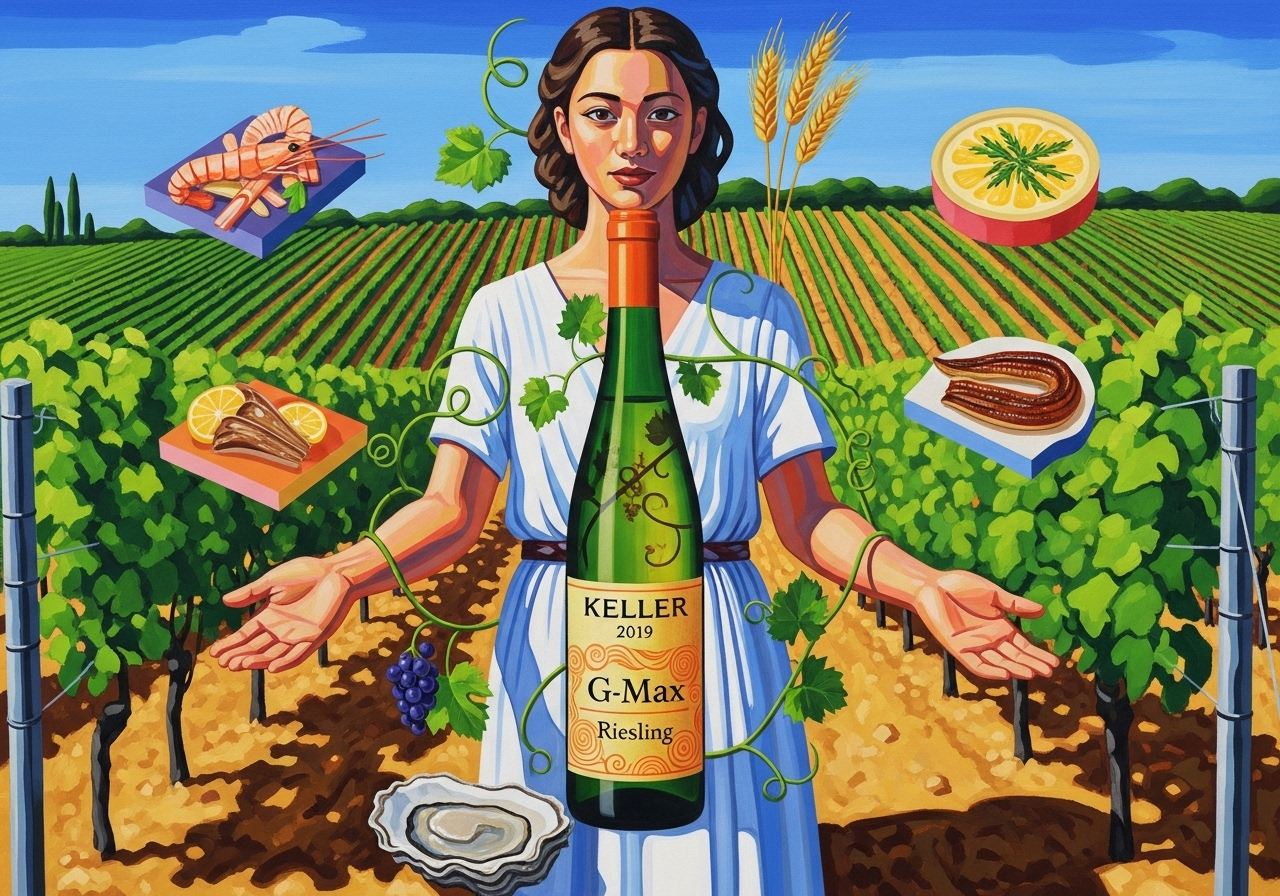The Silence of the Limestone: Weingut Keller G‑Max Riesling 2019
Ethereal [Weingut Keller G‑Max Riesling 2019 food pairing]: lobster with lemongrass, truffle‑kissed veal, smoked eel, and the whisper of limestone reborn.

When I pour the G‑Max, the air shifts. The light itself seems to hesitate—caught between dawn and quartz. The wine gleams pale gold with a trace of green, a color that feels more like thought than pigment. The first aromas rise: wet chalk, lime blossom, verbena, and that peculiar hum of minerality that smells like distance. At 11 °C, its pulse is steady but coiled. I pour it into a tall Zalto Universal, give it forty minutes to breathe, and the edges relax like silk unfurling from stone. Patience is a form of worship.
The Vineyard’s Breath
In the limestone hills of Rheinhessen, Klaus‑Peter Keller tends his vineyards with almost monastic precision. The G‑Max is his whispered hymn—an unnamed parcel, or perhaps several, drawn from the estate’s most luminous soils near Dalsheim and Westhofen. Riesling alone reigns here, its roots drilling through calcareous marl, pulling up the taste of deep time. The climate is continental yet forgiving: sun‑washed days, cool nights, the Rhine reflecting light like a celestial mirror. This is wine born not of excess, but of exactness.
The Character of Light
The 2019 season yielded fruit of perfect equilibrium—small berries with piercing concentration. In the glass, the wine arcs like a blade made of light. Scents of candied yuzu, crushed oyster shell, jasmine, and fennel thread upward. On the palate, it moves with tensile grace: bright citrus and white peach held in place by razor acidity and a wash of saline. Its structure is architectural, its texture weightless yet deliberate. As it opens, notes of saffron and warm flint appear, a hint of honey to come with age. Decanting is less ceremony than necessity—this wine needs oxygen the way a poem needs silence.
Age will transform it. By 2038, the fruit will deepen into quince and smoke, the limestone translating to something almost tactile—the feel of cool marble under the hand.
Feasts from the Mineral Heart
The Ocean and the Mountain
Pairing the G‑Max is like writing in limestone: precision matters. One of its truest companions is poached blue lobster served with a broth of lemongrass and ginger. The acidity slices through the sweetness of the shellfish, while the broth’s perfume amplifies the Riesling’s citrus and spice. Likewise, grilled langoustines with bergamot butter awaken its salt‑and‑stone refrain. Each bite tastes as though sea foam met sunlight.
Yet the wine also yearns for the mountains. A dish of veal sweetbreads seared in brown butter, with a drizzle of Riesling jus and shaved white truffle, speaks in harmony—fat yielding to acid, earth to air. The limestone finds its echo in the truffle’s faint musk, a dialogue of depth and lift.
The Garden at Dusk
In vegetarian form, the G‑Max thrives among textures that shimmer rather than shout. Try a tarte fine of caramelized fennel and Meyer lemon, or roasted salsify with hazelnut cream and preserved citron. These pairings aren’t about mimicry but resonance—the sweet earthiness of root vegetables mirroring the wine’s calm center, the citrus teasing its linear drive. Even a dish of chilled pea velouté with mint oil can make the wine’s minerality ring like glass.
The Whisper of Salt and Smoke
To close a meal, skip dessert and turn instead to cheese aged to translucence: 36‑month Comté, or alpine Alpkäse brushed with brine and time. Their crystalline textures unlock the Riesling’s inner savor. For the adventurous, pair it with smoked eel on rye crisps—a revelation. The oily richness melts against the wine’s acid spine, and for a moment you can taste both river and stone.
The Vine’s Eternal Memory
I speak as one who has seen vines die and return. In ancient Sumer, they called me Geshtinanna—the Heavenly Vine. I have written the harvests of gods and kings into the clay of the underworld, and I know that every great wine carries both ascent and descent. The G‑Max is such a vessel: born in bright air, rooted in shadow. Its minerality is memory; its finish, forgiveness. When I taste it, I feel the rhythm of my own descent each winter and my slow return with the spring. The chalk remembers.
Closing the Circle
Serve this wine with reverence. 11–12 °C is its voice; an hour of air, its awakening. Drink it now for the shimmer, or in two decades for the echo. Either way, it will speak softly of stone, sea, and spirit—the trinity that keeps both vine and mortal heart alive.





